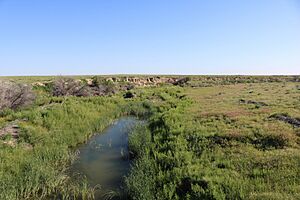Timpas Creek facts for kids

Timpas Creek is a small stream located in the beautiful state of Colorado, USA. This creek flows through parts of Las Animas and Otero counties. It's an interesting place with a history tied to its name and the rocks found nearby.
Contents
What's in a Name? The Story of Timpas Creek
The name "Timpas" has a bit of a mystery around it! When the first European explorers and settlers came to this area, they were from Spain and later Mexico. They gave many places their names.
Spanish Roots of "Timpas"
One idea is that "Timpas" comes from a Spanish word.
- Some think it relates to "timpa" or "timpas", which can mean a part of a blast furnace. This is where hot, melted rock (called slag) would drain out.
- Another idea is that it means "furnace hearth." This makes sense because a special type of rock, called limestone, was found here. This limestone could have been used to build furnaces.
Who Named the Creek First?
There's a friendly debate about whether the creek was named after the rock, or the rock was named after the creek!
- In 1954, a writer named John Dawson said the creek got its name from "Timpas Limestone." This limestone was dug up (quarried) near where the creek meets the Arkansas River. Even today, this limestone is still quarried near Rocky Ford.
- However, a geologist named G.K. Gilbert studied the area in 1896. He said that "Timpas" was already a local name for the limestone found along the creek. This suggests the creek might have been named first, and then the rock got its name from the creek.
The Limestone's New Name
Over time, scientists learn more and sometimes change names to be more accurate.
- G.K. Gilbert realized that the Timpas Limestone was the same as another rock formation called the Fort Hays Limestone.
- So, in 1964, the name "Timpas Limestone" was officially changed. Now, it's known as the Fort Hays Limestone.
Where is Timpas Creek?
Timpas Creek is an important part of the natural landscape in southeastern Colorado. It flows through beautiful areas and eventually joins the larger Arkansas River. This creek helps support local wildlife and plants in its ecosystem.

